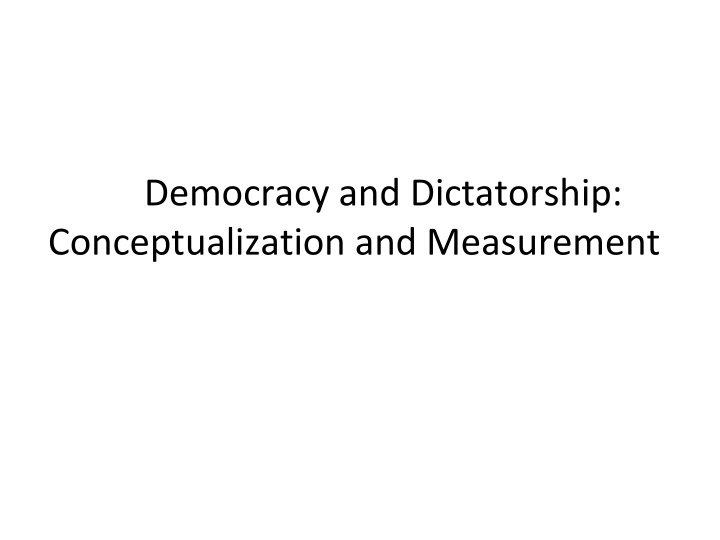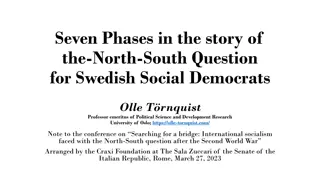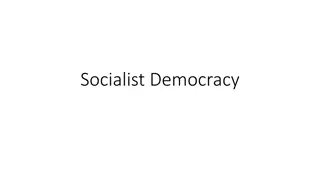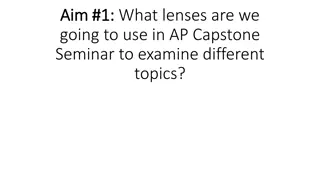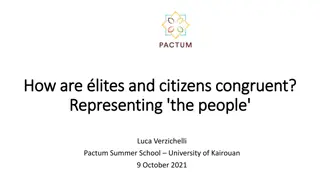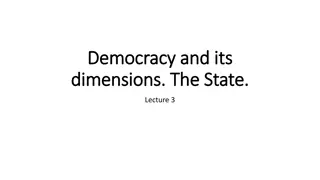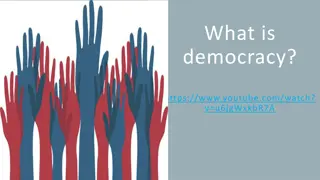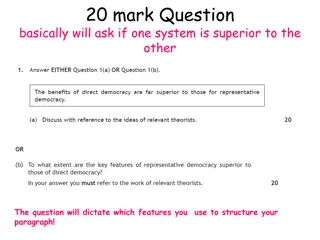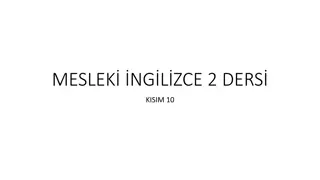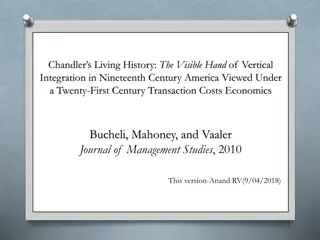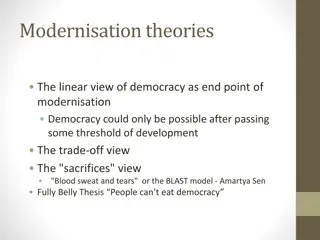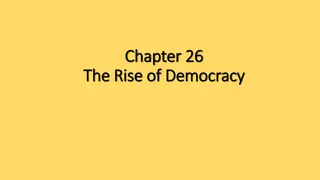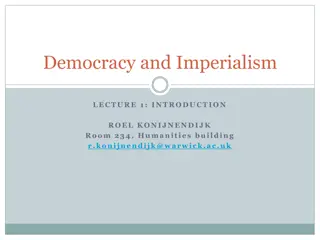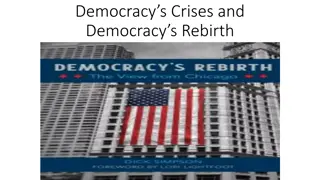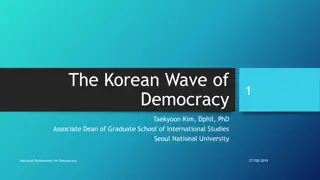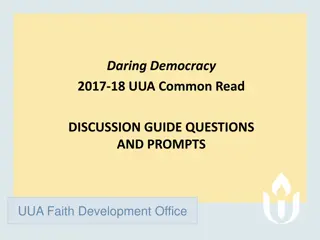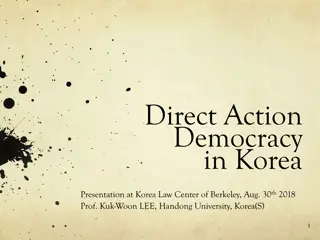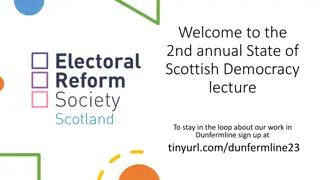Evolution of Democracy: From Early Forms to Modern Systems
Explore the evolution of democracy from early forms where rulers sought consent to govern to modern systems of democratic rule. Early democracy emerged when rulers needed to seek the approval of those they governed, leading to limited participation and direct democracy in various societies. However, early democracy tended to diminish as societies grew larger and rulers found new ways to control populations. Understanding the historical context of democracy sheds light on its diverse manifestations across different cultures and time periods.
Download Presentation

Please find below an Image/Link to download the presentation.
The content on the website is provided AS IS for your information and personal use only. It may not be sold, licensed, or shared on other websites without obtaining consent from the author.If you encounter any issues during the download, it is possible that the publisher has removed the file from their server.
You are allowed to download the files provided on this website for personal or commercial use, subject to the condition that they are used lawfully. All files are the property of their respective owners.
The content on the website is provided AS IS for your information and personal use only. It may not be sold, licensed, or shared on other websites without obtaining consent from the author.
E N D
Presentation Transcript
Democracy and Dictatorship: Conceptualization and Measurement
Common claim: Europeans invented democracy. But if we see the consent of the people as the defining feature of democratic rule, then democracy is a relatively common system of rule in human societies. It has emerged independently in different corners of the world throughout human history.
Early democracy emerged when rulers felt obliged to seek the consent of those over whom they ruled. David Stasavage: Early democracy is a system in which a ruler governed jointly with a council or assembly composed of members of society who were themselves independent from the ruler and not subject to [their] whim.
Early democracy: Ruler requires the consent of assembly members to govern. Limited participation. Direct democracy. Binding local mandates. Assembly decisions not binding.
Rulers had two distinct strategies for accessing the revenue and power they desired: 1. Where conditions were propitious, rulers could create powerful centralized states with the ability to predate on society. 2. Where conditions were less propitious, rulers were forced to rein in their predatory tendencies and seek the consent of those they governed through the use of councils and assemblies.
Early democracy tended to occur in places where it was difficult for rulers to build a state apparatus to monitor and control the population. It was common in hunter-gatherer societies and where people were geographically dispersed and mobile. Early democracy emerged when rulers were dependent on people with credible exit options.
Early democracy tended to disappear: when societies grew in size and direct democracy became less practical. when rulers became less dependent on their citizenry because they found new ways to monitor and coerce the population. when people saw the value of their exit options fall.
Modern democracy is a political system in which representatives of the people are regularly chosen in competitive elections under universal suffrage.
Modern democracy: Representative democracy, not direct democracy. Political inclusion, usually universal suffrage today, is much larger. Political participation is more episodic and largely restricted to elections. No binding local mandates. Assembly decisions, typically taken via majority rule, are binding. A state bureaucracy determines the day-to-day running of a country.
The key defining feature of early and modern democracy is that rulers are forced to seek the consent of the people to govern. Rulers are forced to do this not because some constitutional rule tells them they must but because of the simple fact that they find themselves dependent on people who have credible exit options.
Modern democracy is more inclusive than early democracy largely because rulers find themselves dependent on a wider range of people with credible exit options than in the past. In modern democracy, the consent of the people, or the authorization to rule, is provided through the regular holding of competitive elections.
Why Elections? Elections help us to authorize governments and hold rulers accountable. However, they re also important because they help us to peacefully process conflicts and avoid violence.
Adam Przeworski: Suppose we determine the identity of the government with a coin toss. The mere possibility of an alternation in power may be enough to induce competing political forces to comply with this selection process rather than seek office through force.
The losers care about (1) their chances of prevailing the next time the coin is tossed, (2) the costs of fighting, and (3) the loss they ll suffer from being ruled by someone else. If they have a sufficiently high chance of winning next time, if the costs of fighting are high, and if the loss they ll suffer isn t too great, then the losers may prefer to comply with the coin toss rather than seek power through violence.
While the winner would rather not have to toss the coin again in the future, they may prefer to do so and run the risk of losing than provoke violence by usurping power. To prevent the losers from taking up arms, the winner has an incentive to moderate their policies such that the losers don t suffer too much. The winner also has an incentive not to abuse their incumbency power to manipulate the system (the coin) in such a way that the current losers prospects of winning in the future fall too low.
But why elections and not just a coin toss? Voting provides information about the chances each side has of prevailing in a conflict. Election results show the losers the strength of their forces and who s on their side if they were to reject the election outcome, and they show the winner the strength of the opposition they d face if they were to cancel future elections.
Adam Przeworski: the miracle of democracy is that conflicting political forces obey the results of voting. People who have guns obey those without them. Incumbents risk their control of governmental offices by holding elections. Losers wait for their chance to win office. Conflicts are regulated, processed according to rules, and thus limited. The miracle doesn t work under all conditions!
Transition from Early to Modern Democracy Two events were particularly important for the transition from early democracy to modern democracy: 1. The Glorious Revolution of 1688 in England invented a new kind of parliament and style of governance. 2. The American colonial experience encouraged broad political inclusion. Building on its origins in England and America, the basic features of modern democracy have been adopted all around the world.
Three Waves of Democracy (Samuel Huntington): 1. From early in the 19th century until shortly after World War I (Mainly in Europe, France, Britain, Iceland, Ireland, Italy, and Switzerland). 2. From World War II until the early 1960s (Austria, Brazil, Costa Rica, India, Israel, Italy, Japan, Malaysia, Nigeria, Sri Lanka, Turkey, Uruguay, and West Germany). 3. From the early 1970s (numerous countries in Africa, Asia, Latin America, southern and eastern Europe).
Modern democracy is a relatively new phenomenon. We shouldn t view it as some end point of political evolution. Political institutions such as modern democracy often arise as a by-product of rulers trying to maintain their hold on power. Rulers are constantly experimenting with different types of institutions and forms of political hierarchy in the hopes of gaining a survival advantage over their rivals.
The institutions, such as modern democracy, that we see today are simply those that have survived this process of historical competition. Rulers modify their institutional choices in response to changes in the social, economic, and political environment.
We can expect to see rulers and state elites continue experimenting with different institutional structures to see if they can gain a competitive advantage over their rivals. This could lead to the creation of even more democratic institutions, but it could also lead to the establishment of more dictatorial and predatory forms of political rule.
Research Questions Why are some countries democracies and others dictatorship? Do democracies or dictatorships produce better economic performance? What factors influence democratic survival? All of these questions require that we be able to classify countries as democratic or dictatorial.
Theories about the world are based on abstract concepts. A concept is a mental category or construct that captures the meaning of objects, events, or ideas. Theoretical concepts can t be observed; they exist only in our heads.
When we want to test our theoretical claims, we have to translate our concepts into concrete measures or indicators that we can actually observe. A measure or indicator is a quantification of the thing in which we re interested. The process of translating a concept into a measure is called operationalization we use a particular measure to operationalize a theoretical concept.
A central component of modern democracy is that rulers must seek the consent of the people to govern. But how should we translate this abstract concept into a practical set of criteria for classifying political regimes?
Dahls View of Democracy and Dictatorship A substantive view of democracy classifies political regimes in regard to the outcomes that they produce. A minimalist or procedural view of democracy classifies political regimes in regard to their institutions and procedures.
Robert Dahl proposed a minimalist view of democracy. Two dimensions 1. Contestation captures the extent to which citizens are free to organize themselves into competing blocs in order to press for the policies and outcomes they desire. 2. Inclusion has to do with who gets to participate in the democratic process.
Apartheid South Africa Liechtenstein pre-1984 US pre-1830 US today Switzerland pre-1971 France pre-1945 Contestation China Soviet Union Inclusion
Three measures of democracy and dictatorship 1. Democracy-Dictatorship (DD) Measure 2. Freedom House (FH) Measure 3. Varieties of Democracy (V-Dem) Measure
Democracy-Dictatorship Measure Democracies are regimes in which governmental offices are filled as a consequence of contested elections.
A country is classified as a democracy only if all of the following conditions apply: 1. The chief executive is elected. 2. The legislature is elected. 3. There is more than one party competing in the elections. 4. An alternation in power under identical electoral rules has taken place.
The DD measure builds on Dahls insights in two ways. 1. Minimalist view of democracy. 2. Emphasis on contestation.
The main difference with Dahl is that the DD measure treats regime type as a dichotomy. A dichotomous measure has only two discrete categories or values, such as tall and short . A continuous measure can take on any intermediate value within a given range, such as height in centimeters .
Comparing DDs and Dahls Conceptualization of Regime Type (a) DD s Dichtomous Conceptualization of Regime Type Dictatorships Democracies More Dictatorial Less Dictatorial Less Democratic More Democratic (b) Dahl s Continuous Conceptualization of Regime Type More Dictatorial More Democratic
Freedom House Measure Two categories: 1. Political rights. 2. Civil rights. Based on scores for political and civil rights, Freedom House classifies countries as Free, Partly Free, and Not Free.
The amount of freedom on the political rights dimension is measured by 10 questions, each worth between 0 and 4 points. Three categories: 1. Electoral Process. 2. Political pluralism and participation. 3. Functioning of government. A country s score out of 40 is converted to a 7-point scale.
The amount of freedom on the civil rights dimension is measured by 15 questions, each worth between 0 and 4 points. Four categories: 1. Freedom of expression and belief. 2. Associational and organizational rights. 3. Rule of law. 4. Personal autonomy and individual rights. A country s score out of 60 is converted to a 7-point scale.
A countrys overall Freedom House score is the average of its political and civil rights scores. Freedom House captures Dahl s notion of inclusion and contestation. The big difference is that it employs a substantive view of democracy.
Varieties of Democracy Measure The measurement process behind V-Dem is more complex than that behind DD and Freedom House. A country s annual V-Dem score depends on five core components related to (1) Freedom of Expression, (2) Freedom of Association, (3) Clean Elections, (4), the Percentage of the Population with Suffrage, and (5) Elected Officials.
Varieties of Democracy Measure Each of the five core components depends on several indicators and is measured on a 0-1 scale. They also come with measures of uncertainty. The five scores are then aggregated to produce a final V-Dem score that runs from 0-1.
The V-Dem measure is a minimalist and procedural measure of democracy. It captures Dahl s notion of inclusion and contestation. It conceptualizes and measures democracy along a continuum.
Dictatorship Democracy Not Assessed Democracy-Dictatorship 2021
Dictatorship Mixed Democracy Not Assessed Freedom House 2021
.81 .6 .8 .4 .6 .2 .4 0 .2 Not Assessed V-Dem 2021
Denmark Costa Rica Estonia New Zealand France Germany United Kingdom South Korea Australia Italy Uruguay Japan Chile United States Argentina Jamaica Romania Israel South Africa Dominican Republic Ghana Brazil Namibia Mexico Botswana Indonesia Poland Sri Lanka Tunisia Sierra Leone Ukraine Guatemala Nigeria El Salvador Hungary India Malaysia Zambia Iraq Pakistan Angola Ethiopia Zimbabwe Turkey Russia Nicaragua Cambodia Egypt Iran Somalia Afghanistan Syria Eswatini Myanmar Yemen North Korea China Eritrea Qatar Saudi Arabia 0 0.1 0.2 0.3 0.7 0.8 0.9 1 0.4 0.5 0.6 Level of Democracy (VDem)
Proportion of Democracies Globally 0.7 0.6 Proportion of Democracies 0.5 0.4 0.3 0.2 0.1 0 1940 1950 1960 1970 1980 1990 2000 2010 2020 Year Democracy-Dictatorship V-Dem Freedom House
